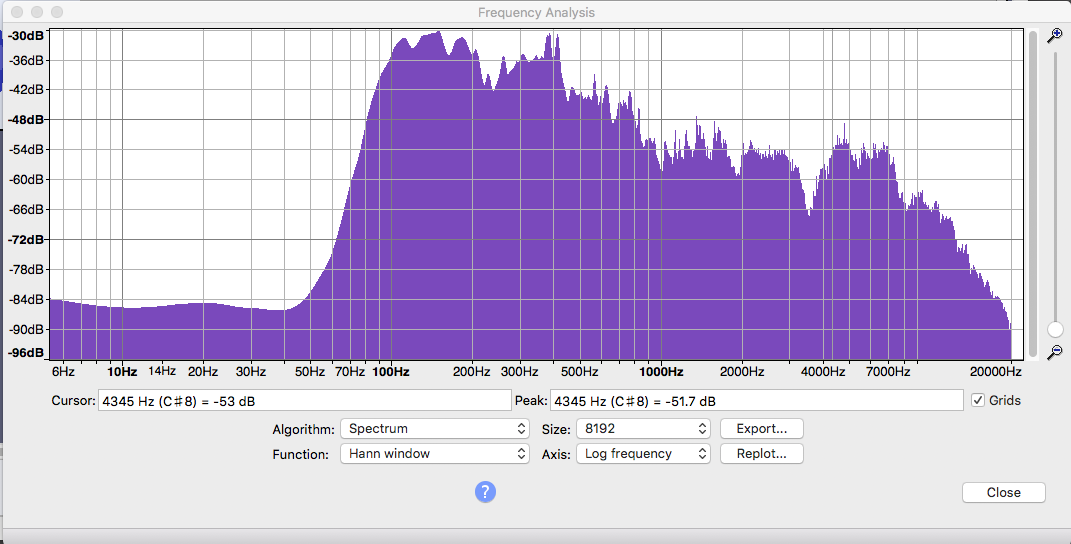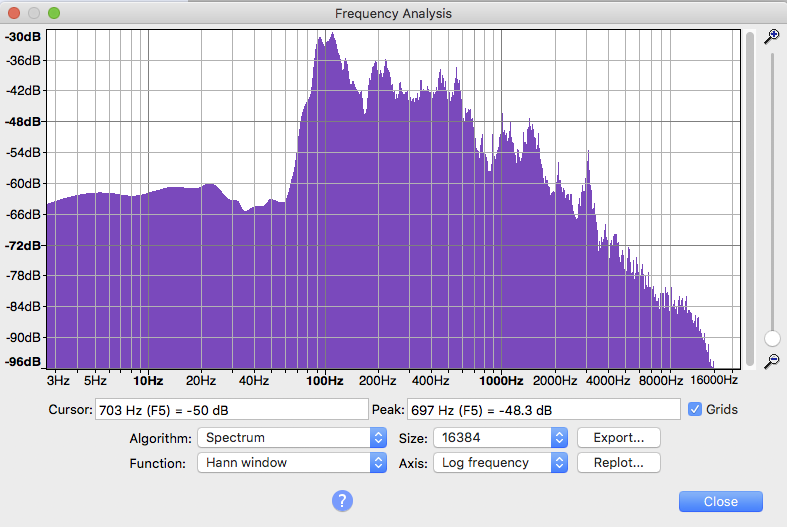Hi, could you please rate this Acx demo sample of just over 2 minutes please?
Appreciate the feedback.
Thanks,
Nate.
Hi, could you please rate this Acx demo sample of just over 2 minutes please?
Appreciate the feedback.
Thanks,
Nate.
Both pass the technical standards checks, but in my opinion they’re a little too crisp and piercing. “AliSS felt thiSS could not be denied.”

That little haystack between 3500 and roughly 8000 (along the bottom) should not be there. That produces the “ice pick in the ear” sound which microphone makers would like you to think is “professional.” It’s not.
There is a tool for this called DeEsser, but I’m not good at using it. It’s really easy to convert one sound quality problem into a different sound quality problem.
https://forum.audacityteam.org/t/updated-de-clicker-and-new-de-esser-for-speech/34283/1
Did you use our Audiobook Mastering Suite, or are you using a different tool collection?
You did violate one technical rule. Never do production in MP3. MP3 quality gets worse each time you make a correction or different theatrical version and the MP3 audiobook submission is required to be Constant Bitrate 192 or higher. Not optional. Export WAV (Microsoft) 16-bit for Raw Reading protection copies and your Edit Master before you make the final MP3.
Are you going to read Alice? It’s a lovely reading, but did ACX agree that was OK? Apparently, ACX doesn’t offer audition services any more, so you won’t know there’s anything wrong until they reject the whole book.
Koz
Thanks for the feedback. Yes I used the Audacity suite to master it - The 3 step : Filter curve etc.
I am just using this to add to my profile samples - not for an actual reading :Where you hear a range of people’s styles.
Can you confirm? - I’ve watched videos where they say you can use public domain for this and I think MP3 is ok for that? Though I posted on here to cut down on file size.
Were the mouth noises ok?- clicks and breath etc. I’ve watched some pro videos where contradicting views are that some breaths and clicks etc are ok/even recommended as long as they are not overbearing.
I’ll look into that DeEsser thanks. Is there a natural way to address the crispness and piercing you hear- Mic placement/Voice technique etc?
Cheers
Nate.
Is there a natural way to address the crispness and piercing you hear
Like dropping a flannel rag over the microphone? Not that I know of. The makers build in the effect in such a way that it’s rough to remove. If you do anything wrong, the voice becomes muffled and dull.
The object is carefully remove the occasional, sharp, gritty SS sounds (classic essing) without affecting anything else. The DeEsser is a bespoke tool. It has to be adjusted for each reader and microphone.
I open a segment of the work with essing and Analyze > Plot Spectrum at that size or greater. You can probably get Timeline Dropdown > Spectrogram to do a similar job.
It’s best to apply the tool after mastering so your voice volume is stable. In general, you don’t have to worry about DeEssing affecting ACX standards because while essing may sound annoying, there’s not a lot of vocal energy (RMS) there to throw things off.
So that leaves threshold and bands. This is where I’m messing with settings to get a feel for what they do. Threshold is pretty simple, the larger the negative number, the more it digs for damage—and the greater the possibility of finding too much work.
I think getting the number of bands wrong can turn SS sounds into FF sounds. Escaping air without the sharp edge. It gives you a speech impediment. There is an odd tradeoff with some settings. You can make it do a perfect job, but it can take a week to complete.
If this was easy, anybody could do it.
Koz
This is me reading a sound test into a Zoom stand-alone voice recorder (not a USB microphone). This sounds like me, there’s no essing, and there’s no haystack on the right.

More importantly, if I wanted to make myself a little brighter, it’s easy done with with Effect > Bass and Treble, Effect > Filter Curve, or Effect > Graphic EQ. No permanent distortions built-in.
Koz
It’s very good, apart from the excessive sibilance.
I’m with Koz: the only cure is a de-esser …
Depending on how you’re listening the sibilance may not sound excessive.
With in-ear headphones the sibilance, (particularly “ch”), is piercing.
On low-fi speakers it may sound OK because they are attenuating higher frequencies where sibilance lives.
Post a pix of the DeEsser control panel you used.
Koz
Thanks. I agree. Once it was pointed out it became obvious.
So I’ll get on trying the D’esser plugin.
Cheers
When Trebor publishes his settings, that should give you a good place to start.
Koz
When Trebor publishes his settings, that should give you a good place to start.

The threshold for Paul-L’s de-esser should be close to the RMS of the audio, (+/-2 dB).
(IMO leave the other De-Esser settings as shown).
Paul-L’s de-esser is a multi-band brickwall limiter, rather than multi-band compressor,
so it can sound unnatural when removes a big chunk of loud sibilance: it shaves it off flat.
A workaround is to create an in-sync duplicate track of the original,
and mix that in with the de-essed version, at about-20dB below the de-essed version.
Then the de-essed sibilance then has some variation to it, rather than shaved uniformly flat.
Thanks Trebor